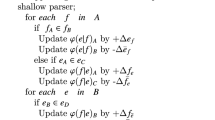Abstract
Currently, computer-aided machine translation (MT) processes play a significant role in natural language processing used to translate a specified language into another language like English to Spanish, Latin to French. During the translation process, and particularly during phrase composition, MT systems may exhibit several issues, including failure to produce high quality translations, increased time consumption, diminished linguistic precision and complexity. This research introduces an optimized cognitive assisted statistical MT process that is intended to reduce these difficulties. This process uses a supervised machine learning technique (OCSMT-SMT) for natural language processing that is intended to translate phrases with a higher degree of precision than other Support Vector Machine, Linear Regression, Decision Trees, Naïve Bayes, and K-Nearest Neighbor MT techniques. The method introduced here uses semantic operations to examine the collected messages that are processed in network and obtained results have been stored in the memory to get the exact translation which helps to learn phrase semantics using MT. The OCSMT-SMT approach enables smarter, faster decision making regarding phrase translations, which greatly reduces translation time. The efficiency of this approach is evaluated using the bilingual evaluation understudy (BLEU) and Better Evaluation as Ranking (BEER) metrics for English language phrase datasets in English language. This ensures the high precision while performing the MT process.








Similar content being viewed by others
References
Mehta N, Devarakonda MV (2018) Machine learning, natural language programming, and electronic health records: the next step in the artificial intelligence journey? J Allergy Clin Immunol 141(6):2019–2021
Millen D, Coelho LMR (2019) U.S. Patent Application No. 15/695,209
Xu W, Xu F, Zou X, Xu Z (2018) The cognitive features of programming language and natural language. In: International conference on intelligence science. Springer, Cham, pp 184–190
Lakhani P, Prater AB, Hutson RK, Andriole KP, Dreyer KJ, Morey J, Prevedello LM, Clark TJ, Geis JR, Itri JN, Hawkins CM (2018) Machine learning in radiology: applications beyond image interpretation. J Am Coll Radiol 15(2):350–359
Baydin AG, Pearlmutter BA, Radul AA, Siskind JM (2018) Automatic differentiation in machine learning: a survey. J Mach Learn Res 18:1–43
Venkataraman NL, Kumar R, Shakeel PM (2019) Ant lion optimized bufferless routing in the design of low power application specific network on chip. Circuits Syst Signal Process. https://doi.org/10.1007/s00034-019-01065-6
Li J, Ning Z, Jedari B, Xia F, Lee I, Tolba A (2016) Geo-social distance-based data dissemination for socially aware networking. IEEE Access 4:1444–1453
Bai X, Zhang F, Hou J, Xia F, Tolba A, Elashkar E (2017) Implicit multi-feature learning for dynamic time series prediction of the impact of institutions. IEEE Access 5:16372–16382
Crangle CE, Wang R, Perreau-Guimaraes M, Nguyen MU, Nguyen DT, Suppes P (2019) Machine learning for the recognition of emotion in the speech of couples in psychotherapy using the Stanford Suppes Brain Lab Psychotherapy Dataset. arXiv preprint arXiv:1901.04110
Tolba A (2019) Content accessibility preference approach for improving service optimality in internet of vehicles. Comput Netw 152:78–86
Shakeel PM, Burhanuddin MA, Desa MI (2019) Lung cancer detection from CT image using improved profuse clustering and deep learning instantaneously trained neural networks. Measurement. https://doi.org/10.1016/j.measurement.2019.05.027
Alarifi A, Tolba A, Al-Makhadmeh Z, Said W (2018) A big data approach to sentiment analysis using greedy feature selection with cat swarm optimization-based long short-term memory neural networks. J Supercomput. https://doi.org/10.1007/s11227-018-2398-2
Baskar S, Periyanayagi S, Shakeel PM, Dhulipala VS (2019) An energy persistent range-dependent regulated transmission communication model for vehicular network applications. Comput Netw. https://doi.org/10.1016/j.comnet.2019.01.027
Wang J, Kong X, Rahim A, Xia F, Tolba A, Al-Makhadmeh Z (2017) IS2Fun: identification of subway station functions using massive urban data. IEEE Access 5:27103–27113
Chen W, Yan X, Zhao Z, Hong H, Bui DT, Pradhan B (2019) Spatial prediction of landslide susceptibility using data mining-based kernel logistic regression, naive Bayes and RBF network models for the Long County area (China). Bull Eng Geol Environ 78(1):247–266
Ahmed AM, Kong X, Liu L, Xia F, Abolfazli S, Sanaei Z, Tolba A (2017) BoDMaS: bio-inspired selfishness detection and mitigation in data management for ad-hoc social networks. Ad Hoc Netw 55:119–131
Jedari B, Xia F, Chen H, Das SK, Tolba A, Al-Makhadmeh Z (2019) A social-based watchdog system to detect selfish nodes in opportunistic mobile networks. Future Gener Comput Syst 92:777–788
Rathord P, Jain A, Agrawal C (2019) A comprehensive review on online news popularity prediction using machine learning approach. Int J Online Sci 5(1):7–7
Zhang F, Fleyeh H, Wang X, Lu M (2019) Construction site accident analysis using text mining and natural language processing techniques. Autom Constr 99:238–248
Liu F, Weng C, Yu H (2019) Advancing clinical research through natural language processing on electronic health records: traditional machine learning meets deep learning. In: Richesson R, Andrews J (eds) Clinical research informatics. Springer, Cham, pp 357–378
Da Li RR, Ptaszynski M, Araki K (2019) A novel machine learning-based sentiment analysis method for Chinese social media considering Chinese slang lexicon and emoticons
Su M, Whitman J, Hermon G (eds) (1994) Syntactic theory and first language acquisition: cross-linguistic perspectives—volume 1: heads, projections, and learnability—volume 2: binding, dependencies, and learnability. Psychology Press, Hove
Stepanov A, Andreetta S, Stateva P, Zawiszewski A, Laka I (2019) Anomaly detection in processing of complex syntax by early L2 learners. Second Lang Res. https://doi.org/10.1177/0267658319827065
Weber K, Christiansen MH, Indefrey P, Hagoort P (2019) Primed from the start: syntactic priming during the first days of language learning. Lang Learn 69(1):198–221
Mohamed Shakeel P, Baskar S, Selvakumar S (2019) Retrieving multiple patient information by using the virtual MIMO and path beacon in wireless body area network. Wireless Pers Commun. https://doi.org/10.1007/s11277-019-06525-5
Sadrzadeh M, Purver M, Hough J, Kempson R (2018) Exploring semantic incrementality with dynamic syntax and vector space semantics. arXiv preprint arXiv:1811.00614
Schmitz P, Sanmartin F, Francesconi E, Hajlaoui N, Batouche B, Stellato A (2018) Automatic alignment of multilingual resources in the linguistic linked open data cloud. J Open Access Libr 6:1
Young T, Hazarika D, Poria S, Cambria E (2018) Recent trends in deep learning based natural language processing. IEEE Comput Intell Mag 13(3):55–75
Fonferko-Shadrach B, Lacey A, Akbari A, Thompson S, Ford D, Lyons R, Rees M, Pickrell O (2018) Using natural language processing to extract structured epilepsy data from unstructured clinic letters. Int J Popul Data Sci 3(4):108
Story P, Zimmeck S, Ravichander A, Smullen D, Wang Z, Reidenberg J, Russell NC, Sadeh N (2019) Natural language processing for mobile app privacy compliance
Koleck TA, Dreisbach C, Bourne PE, Bakken S (2019) Natural language processing of symptoms documented in free-text narratives of electronic health records: a systematic review. J Am Med Inform Assoc 26(4):364–379
Manogaran G, Baskar S, Shakeel PM, Chilamkurti N, Kumar R (2019) Analytics in real time surveillance video using two-bit transform accelerative regressive frame check. Multimed Tools Appl 15:12. https://doi.org/10.1007/s11042-019-7526-3
Tolba A, Elashkar E (2018) Soft computing approaches based bookmark selection and clustering techniques for social tagging systems. Clust Comput. https://doi.org/10.1007/s10586-018-2014-5
Rahim A, Qiu T, Ning Z, Wang J, Ullah N, Tolba A, Xia F (2019) Social acquaintance based routing in vehicular social networks. Future Gener Comput Syst 93:751–760
Said O, Tolba A (2018) Design and performance evaluation of mixed multicast architecture for internet of things environment. J Supercomput 74:3295–3328
Acknowledgements
The authors extend their appreciation to the Deanship of Scientific Research at King Saud University for funding this work through Research Group No. RG-1440-078.
Author information
Authors and Affiliations
Corresponding author
Additional information
Publisher’s Note
Springer Nature remains neutral with regard to jurisdictional claims in published maps and institutional affiliations.
Rights and permissions
About this article
Cite this article
Alarifi, A., Alwadain, A. An optimized cognitive-assisted machine translation approach for natural language processing. Computing 102, 605–622 (2020). https://doi.org/10.1007/s00607-019-00741-4
Received:
Accepted:
Published:
Issue Date:
DOI: https://doi.org/10.1007/s00607-019-00741-4
Keywords
- Computer aided machine translation
- Cognitive assisted statistical machine translation
- BLEU
- BEER
- Cognitive machine learning




